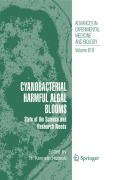
Interagency, international symposium on cyanobacterial harmful algal blooms (ISOC-HAB): state-of-the-science and research needs
Hudnell, H.K.
Cyanobacteria are single-celled organisms that live in fresh, brackish, and marine water. They use sunlight to make their own food. In warm, nutrient-rich environments, microscopic cyanobacteria can grow quickly, creating blooms thatspread across the water’s surface and may become visible. Because of the color, texture, and location of these blooms, the common name for cyanobacteria isblue-green algae. However, cyanobacteria are related more closely to bacteriathan to algae. Cyanobacteria are found worldwide, from Brazil to China, Australia to the United States. In warmer climates, these organisms can grow year-round. Scientists have called cyanobacteria the origin of plants, and have credited cyanobacteria with providing nitrogen fertilizer for rice and beans. But blooms of cyanobacteria are not always helpful. When these blooms become harmful to the environment, animals, and humans, scientists call them cyanobacterial harmful algal blooms (CyanoHABs). A synopsis which proposes a National Research Plan for Cyanobacteria and their Toxins INDICE: From the contents Forward.- An Overview of the Interagency, International Symposium on Cyanobacterial Harmful Algal Blooms (ISOC-HAB): Advancingthe Scientific Understanding of Freshwater Harmful Algal Blooms.- A Synopsis of Research Needs Identified at the Interagency, International Symposium on Cyanobacterial Harmful Algal Blooms (ISOC-HAB).- Occurrence of Cyanobacterial Harmful Algal Blooms Workgroup Report.- A world overview-one-hundred-twenty-seven years of research on toxic cyanobacteria--Where do we go from here?- Toxic Cyanobacteria in Florida Waters.- Nebraska Experience.- Cyanobacterial Toxins in New York and the Lower Great Lakes Ecosystems.- Occurrence Workgroup Poster Abstracts.- Causes, Prevention, and Mitigation Workgroup Report.- Nutrient andother environmental controls of harmful cyanobacterial blooms along the freshwater–marine continuum.
- ISBN: 978-0-387-75864-0
- Editorial: Springer
- Encuadernacion: Cartoné
- Páginas: 500
- Fecha Publicación: 01/01/2008
- Nº Volúmenes: 1
- Idioma: Inglés
